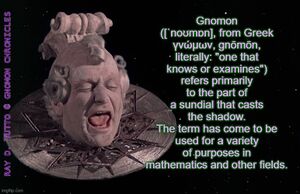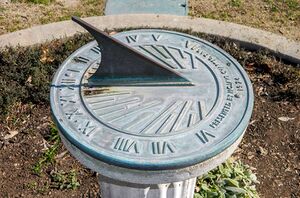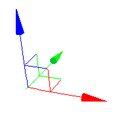Gnomon (nonfiction): Difference between revisions
No edit summary |
No edit summary |
||
| (3 intermediate revisions by the same user not shown) | |||
| Line 1: | Line 1: | ||
[[File:Gnomon - definition - Ray D. Tutto.jpg|thumb|Gnomon - definition - as read aloud by Ray D. Tutto.]] | |||
[[File:Sundial-587636 960 720.jpg|thumb|Sundial with gnomon casting shadow.]]'''Gnomon''' ([ˈnoʊmɒn], from Greek γνώμων, '''gnōmōn''', literally: "one that knows or examines") refers primarily to the part of a [[Sundial (nonfiction)|sundial]] that casts the shadow. | [[File:Sundial-587636 960 720.jpg|thumb|Sundial with gnomon casting shadow.]]'''Gnomon''' ([ˈnoʊmɒn], from Greek γνώμων, '''gnōmōn''', literally: "one that knows or examines") refers primarily to the part of a [[Sundial (nonfiction)|sundial]] that casts the shadow. | ||
The term has come to be used for a variety of purposes in [[mathematics (nonfiction)|mathematics]] and other fields. | The term has come to be used for a variety of purposes in [[mathematics (nonfiction)|mathematics]] and other fields. | ||
== History == | |||
Anaximander (610–546 BC) is credited with introducing this Babylonian instrument to the Greeks. | Anaximander (610–546 BC) is credited with introducing this Babylonian instrument to the Greeks. | ||
| Line 21: | Line 24: | ||
<gallery> | <gallery> | ||
File:3DGraphicsGnomon.png|Young gnomon eager to cast first shadow. | File:3DGraphicsGnomon.png|Young gnomon eager to cast first shadow. | ||
File:200px-Gnomon.svg.png|A gnomon as in Euclid book II, showing off its moves. | File:200px-Gnomon.svg.png|A gnomon as in Euclid book II, showing off its moves. | ||
</gallery> | </gallery> | ||
| Line 28: | Line 32: | ||
* [[Forbidden Ratio]] | * [[Forbidden Ratio]] | ||
* [[Gnomon | * [[Gnomon algorithm]] | ||
* [[Gnomon Chronicles]] | |||
* [[Mathematics]] | * [[Mathematics]] | ||
| Line 37: | Line 42: | ||
* [[Sundial (nonfiction)]] | * [[Sundial (nonfiction)]] | ||
External links | == External links == | ||
* [https://en.wikipedia.org/wiki/Gnomon Gnomon] @ Wikipedia | * [https://en.wikipedia.org/wiki/Gnomon Gnomon] @ Wikipedia | ||
=== Social media === | |||
* [https://twitter.com/GnomonChronicl1/status/1701770375841951898 Post] @ Twitter (12 September 2023) | |||
* [https://twitter.com/GnomonChronicl1/status/1421102174516490247 Post] @ Twitter (30 July 2021) | |||
[[Category:Nonfiction (nonfiction)]] | [[Category:Nonfiction (nonfiction)]] | ||
[[Category:Mathematics (nonfiction)]] | [[Category:Mathematics (nonfiction)]] | ||
Latest revision as of 18:33, 12 September 2023
Gnomon ([ˈnoʊmɒn], from Greek γνώμων, gnōmōn, literally: "one that knows or examines") refers primarily to the part of a sundial that casts the shadow.
The term has come to be used for a variety of purposes in mathematics and other fields.
History
Anaximander (610–546 BC) is credited with introducing this Babylonian instrument to the Greeks.
Oenopides used the phrase drawn gnomon-wise to describe a line drawn perpendicular to another.
Later, the term was used for an L-shaped instrument like a steel square used to draw right angles. This shape may explain its use to describe a shape formed by cutting a smaller square from a larger one.
Euclid extended the term to the plane figure formed by removing a similar parallelogram from a corner of a larger parallelogram.
Hero of Alexandria defined a gnomon as that which, when added to an entity (number or shape), makes a new entity similar to the starting entity.
In this sense Theon of Smyrna used it to describe a number which added to a polygonal number produces the next one of the same type. The most common use in this sense is an odd integer especially when seen as a figurate number between square numbers.
The Chinese used the gnomon. It is mentioned in the 2nd century Nine Chapters on the Mathematical Art as being used much earlier by the Duke of Zhou (11th century BC).
In the News
Fiction cross-reference
Nonfiction cross-reference
External links
- Gnomon @ Wikipedia



